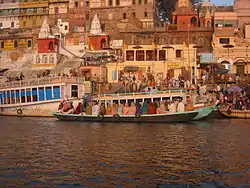
Ghat, a term used in the Indian subcontinent, refer to the series of steps leading down to a body of water or wharf, such as a bathing or cremation place along the banks of a river or pond, the Ghats in Varanasi, Dhobi Ghat or the Aapravasi Ghat.[1][2]
Etymology
The origin of the English 'ghat' is Sanskrit: घट्ट, ghaṭṭa and is normally translated as ghaṭ, quay, landing or bathing place, as well as, steps by a river-side.[3] The word 'ghat' has also been derived from Dravidian etymons such as the Tamil and Kannada word kaadu (காடு/ಕಾಡು; forest, side of a mountain, ridge) or Telugu katta and gattu (dam and embankment).
Types
River ghats
These are bathing wharves on a river.[4] The numerous significant ghats along the Ganges are the Varanasi ghats (the city of Varanasi has 88 ghats) and generically the "ghats of the Ganges". Most of these were constructed under the patronage of various Maratha rulers such as Ahilyabai Holkar (Queen of the Malwa Kingdom from 1767 to 1795) in the 18th century.[5]
In Madhya Pradesh in central India there are further significant ghats along the Narmada River. People who live on the steps are also called ghats.
Shmashana, the cremation ghats
.jpg.webp)
Ghats such as these are useful for both mundane purposes (such as cleaning) and religious rites (i.e. ritual bathing or ablutions); there are also specific "shmashana" or "cremation" ghats where bodies are cremated waterside, allowing ashes to be washed away by rivers; notable ones are Nigambodh Ghat and Raj Ghat in Delhi on the Yamuna, the latter of which was the cremation area for Mohandas Karamchand Gandhi and numerous political leaders after him, and the Manikarnika Ghat at Varanasi on the Ganges.[6]
As place name suffix
"Ghat" and "Ghata" is also a suffix used in several place names across the subcontinent. This is an incomplete list:
- Balaghat, Madhya Pradesh, India
- Balurghat, West Bengal, India
- Batiaghata, Khulna, Bangladesh
- Charghat, Rajshahi, Bangladesh
- Chunarughat, Habiganj, Bangladesh
- Devghat, Nepal
- Gaighat, Nepal
- Ghatail, Tangail, Bangladesh
- Ghoraghat, Dinajpur, Bangladesh
- Goalandaghat, Rajbari, Bangladesh
- Golaghat, Assam, India
- Gowainghat, Sylhet, Bangladesh
- Haluaghat, Mymensingh, Bangladesh
- Kanaighat, Sylhet, Bangladesh
- Pasighat, Arunachal Pradesh, India
- Patharghata, Barguna, Bangladesh
- Saghata, Gaibandha, Bangladesh
Outside Indian subcontinent
The word is also used in some places outside the Indian subcontinent. For example, in George Town, Penang in Malaysia, the label "Ghaut" is used to identify the extensions of those streets which formerly ended in ghats before reclamation of the quayside (e.g., Church St Ghaut, in Malay Gat Lebuh Gereja, is the name of the extension of Church St beyond where the street used to descend to the water via a ghat). In both Penang and Singapore, there are areas named Dhoby Ghaut (dhobi meaning "launderer" or "laundry", depending on whether it refers to a person or a business).
Aapravasi Ghat or The Immigration Depot is a building complex located in Port Louis on the Indian Ocean island of Mauritius, the first British colony to receive indentured, or contracted, labour workforce from India.[7] From 1849 to 1923, half a million Indian indentured labourers passed through the Immigration Depot, to be transported to plantations throughout the British Empire. The large-scale migration of the laborers left an indelible mark on the societies of many former British colonies, with Indians constituting a substantial proportion of their national populations.[8] In Mauritius alone, 68 percent of the current total population is of Indian ancestry. The Immigration Depot has thus become an important reference point in the history and cultural identity of Mauritius.[9][10]
See also
References
- ↑ Sunithi L. Narayan, Revathy Nagaswami, 1992, Discover sublime India: handbook for tourists, Page 5.
- ↑ Ghat definition, Cambridge dictionary.
- ↑ Source: Monnier-Williams Sanskrit-English Dictionary, ghaṭṭa;
- ↑ Bose, Melia Belli (2017). "Women, Gender and Art in Asia, c. 1500-1900. Routledge. ISBN 9781351536554. Retrieved 18 August 2021.
- ↑ also it is a component which help the people to worship their lord and uses for tarpan. Eck, Diana L. (1999). Banaras : city of light (repr. ed.). New York: Columbia University Press. pp. 90, 222. ISBN 9780231114479. Retrieved 5 September 2017.
- ↑ "Funeral pyre to be set up in Lahore". Daily Times Pakistan. Archived from the original on 2007-02-13.
- ↑ Deerpalsingh, Saloni. "An Overview of Indentured Labour Immigration in Mauritius". Global People of Indian Origin (GOPIO) Souvenir Magazine, July 2007. Archived from the original on 2013-08-04. Retrieved 11 September 2009.
- ↑ "The Caribbean" (PDF). High Level Committee on Indian Diaspora. Archived from the original (PDF) on 2009-06-19. Retrieved 11 September 2009.
- ↑ Torabully, Khal (2 November 2007). "Coolitude and the symbolism of the Aapravasi ghat". Retrieved 10 September 2009.
- ↑ "Mauritius: History and Remembrance". allAfrica. 2 November 2004. Retrieved 4 November 2004.
External links
- Ghats of Varanasi, webpage at Varanasi official website.
